#178: The Family Gomphidiaceae
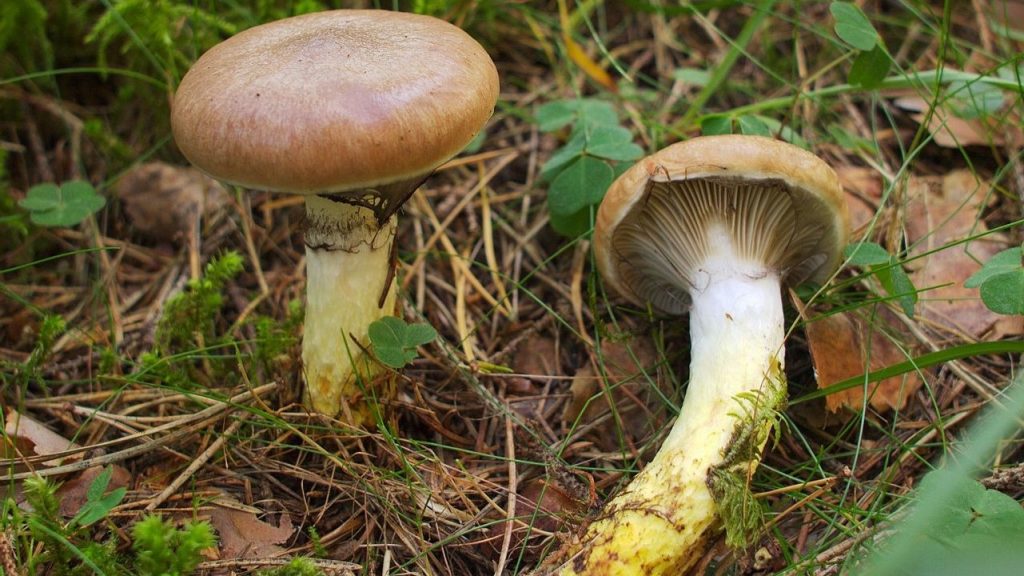
Mushrooms in the family Gomphidiaceae, such as this Gomphidius glutinosus, have black spore prints, decurrent gills, and usually slimy caps. Here, you can clearly see the partial veil (the translucent, stringy membrane covering the gills) that is collecting the mushrooms’ black spores.
The family Gomphidiaceae is small but easy to identify. Mushrooms in this group produce gray to black spores, have decurrent gills, and are shaped like tent pegs. All the fungi in the Gomphidiaceae are mycorrhizal and have some degree of a slimy cap. This is not surprising since their closest relatives are the slimy-capped boletes in the genus Suillus.1,2
Description
The name Gomphidius (the main genus in the family) translates to “little stake,” which refers to the shape of Gomphidiaceae mushrooms. When young, Gomphidiaceae mushrooms have a hemispherical pileus supported by a central stipe that tapers down to a point. This shape is reminiscent of a stocky nail or a wooden tent stake.1
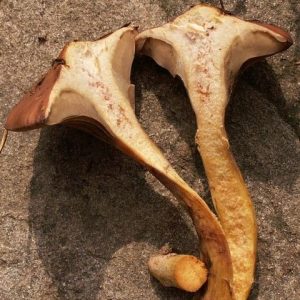
This sliced Chroogomphus rutilus clearly shows the decurrent gills typical of the Gomphidiaceae family. Chroogomphus species like this one have orangish flesh on the inside.
The pileus of a Gomphidiaceae mushroom is variable, but usually exhibits some degree of sliminess when wet. Underneath, the spore-producing tissue is arranged into thick gills that radiate out from the central stipe. The gills are usually decurrent, but some may be merely attached. Some of the mushrooms produce a partial veil that covers the young gills. In older specimens, this veil often leaves a ring of slime around the stipe. Perhaps the most important feature for identifying this group is its gray to black spore print, which easily sets it apart from all but one other major group of agarics.1–4
Fungi in the family Gomphidiaceae are ectomycorrhizal with conifers in the family Pinaceae.5 Look for these mushrooms fruiting on the ground in conifer woods, where they sometimes fruit in large numbers. The Gomphidiaceae occur only in the northern hemisphere, so don’t expect to find them south of the equator (unless, perhaps, you’re in a stand of imported conifer trees).2
There are two main genera in the Gomphidiaceae: Gomphidius and Chroogomphus. To differentiate between these two genera, you will want young specimens and should probably cut one in half. Young Gomphidius mushrooms have white tissue inside the pileus and stipe and usually have yellow tissue near the base of the stipe. In wet conditions, Gomphidius mushrooms have a pileus that is slimy to gelatinous. Gomphidius species grow under Abietoideae (firs, cedars, and hemlocks), Lariceideae (larches and douglas-firs), and Piceoideae (spruces) trees. Chroogomphus, however, produces mushrooms that are dry to sticky in humid conditions and have orangish flesh on the inside when young. These mushrooms appear under Pinoideae (pines) trees, making it theoretically possible to differentiate between the groups based on habitat. Because of their habitat, Chroogomphus species are often called “pine spikes.”1–6 If you’re still not sure which genus your mushroom belongs to and you have access to a microscope, you can check how the cells react to Melzer’s reagent. Chroogomphus cells will turn bluish when stained with Melzer’s, while Gomphidius cells will not.3
Edibility
The Gomphidiaceae are a fairly benign group of mushrooms. All the species that occur in North America are edible, but not particularly interesting.1,2 When collecting Gomphidiaceae mushrooms for the table, make sure to check for a black spore print and decurrent gills, a combination that is unique to this family. If you choose to eat one of these mushrooms, you should remove as much of the slime as possible.1 Removing the slime from a Suillus mushroom makes it less toxic, but I don’t think the same is true for Gomphidiaceae mushrooms. After cooking, Gomphidiaceae mushrooms usually become slimy.2 Most people consider this an undesirable trait, but others may enjoy it because the sliminess adds culinary interest.
Similar Species
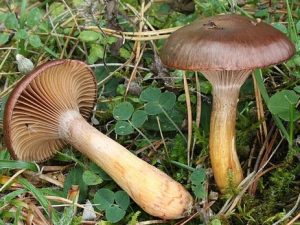
Gomphidiaceae mushrooms, such as this Chroogomphus rutilus can appear similar to Paxillus or Phylloporus, but neither of those genera have black spores.
There is only one other group of mushrooms with black spores: the coprinoid mushrooms (inky caps, FFF#177). Coprinoid mushrooms are thin and fragile and/or have gills that liquefy, which readily distinguishes them from the Gomphidaceae. If your mushroom has a black spore print, it will be easy to narrow it down to one of these groups.
Without looking at spore print color, Gomphidiaceae mushrooms can appear similar to mushrooms of Paxillus or Phylloporus.3 Both of those genera are also related to boletes,7 which explains why the three lineages produce mushrooms that look alike. In Paxillus (see FFF#027), the gills are easily peeled away from the pileus in a single layer.3 This feature is common among boletes,8 which hints at the taxonomic relationships of Paxillus. Phylloporus mushrooms (FFF#187) produce gills that are thick, yellow, and have a wax-like texture. This distinctive combination is not found in the Gomphidiaceae.3
It is more likely that you will confuse the Gomphidiaceae with other fungi because of the name. The family Gomphaceae is very similar in spelling, but it contains chanterelles and coral mushrooms. Another confusing name belonging to that family is the chanterelle genus Gomphus, which similar to Gomphidius only in spelling.
Taxonomy
Even though the Gomphidiaceae have true gills and are considered agarics, they are not related to any other agarics. Most gilled mushrooms belong to the order Agaricales, but the Gomphidiaceae belong to the order Boletales. The Boletales contain the boletes (FFF#028), the earthballls, and a few lineages of gilled mushrooms.7 Within the Boletales, the Gomphidiaceae are most closely related to the bolete genus Suillus.4,5 Suillus species are known for their slimy caps, radially-arranged pores, and growth under conifers.2,4 All these features are very similar to the defining characteristics of the Gomphidiaceae. This situation, where both the Gomphidiaceae and the Agaricales evolved gills independently, is a great example of convergent evolution.
| Kingdom | Fungi |
| Division | Basidiomycota |
| Subdivision | Agaricomycotina |
| Class | Agaricomycetes |
| Subclass | Agaricomycetidae |
| Order | Boletales |
| Family | Gomphidiaceae Maire ex Jülich9 |
This post describes a group of mushrooms and as such the information on this page (including the pictures) cannot be used to identify any mushroom in particular.
This post does not contain enough information to positively identify any mushroom. When collecting for the table, always use a local field guide to identify your mushrooms down to species. If you need a quality, free field guide to North American mushrooms, I recommend Michael Kuo’s MushroomExpert.com. Remember: when in doubt, throw it out!
See Further:
http://www.svims.ca/council/Gomphi.htm
http://www.mushroomexpert.com/gomphidius.html
http://www.mushroomexpert.com/chroogomphus.html
https://www.jstor.org/stable/3761977?seq=1#page_scan_tab_contents
Citations
- Scates, K. Field key to GOMPHIDIACEAE in the Pacific Northwest. Pacific Northwest Key Council (2017). Available at: http://www.svims.ca/council/Gomphi.htm. (Accessed: 16th February 2017)
- Miller, O. K. & Miller, H. North American mushrooms: a field guide to edible and inedible fungi. (Falcon Guide, 2006).
- Kuo, M. The Genus Chroogomphus. MushroomExpert.Com (2007). Available at: http://www.mushroomexpert.com/chroogomphus.html. (Accessed: 16th February 2017)
- Kuo, M. The Genus Gomphidius. MushroomExpert.Com (2007). Available at: http://www.mushroomexpert.com/gomphidius.html. (Accessed: 16th February 2017)
- Miller, O. K. The Gomphidiaceae Revisited: A Worldwide Perspective. Mycologia 95, 176–183 (2003).
- Pinaceae. Wikipedia (2016).
- Kuo, M. Mushroom Taxonomy: The Big Picture. MushroomExpert.Com (2014). Available at: http://www.mushroomexpert.com/taxonomy.html. (Accessed: 16th February 2017)
- Kuo, M. Polyporales: The Polypores (MushroomExpert.Com). MushroomExpert.Com (2004). Available at: http://www.mushroomexpert.com/polyporales.html. (Accessed: 17th February 2017)
- Gomphidiaceae. Mycobank Available at: http://www.mycobank.org/name/Gomphidiaceae&Lang=Eng. (Accessed: 16th February 2017)

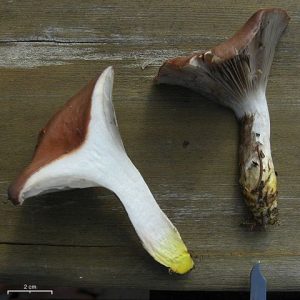
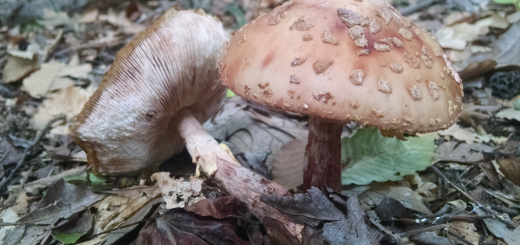
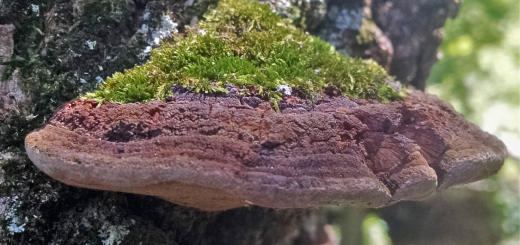
![#007: Omphalotus illudens, the Jack-O-Lantern Mushroom [Archived]](https://www.fungusfactfriday.com/wp-content/themes/hueman/assets/front/img/thumb-medium-empty.png)





![#011: Characteristics of Kingdom Fungi [Archived]](https://www.fungusfactfriday.com/wp-content/themes/hueman/assets/front/img/thumb-small-empty.png)

2 Responses
[…] to confuse with any other group of mushroom. The closest match would be the Gomphidiaceae (FFF#178), which have gray to black spore prints but feature thick flesh and decurrent gills. Coprinoid […]
[…] Gomphidiaceae29,30 […]